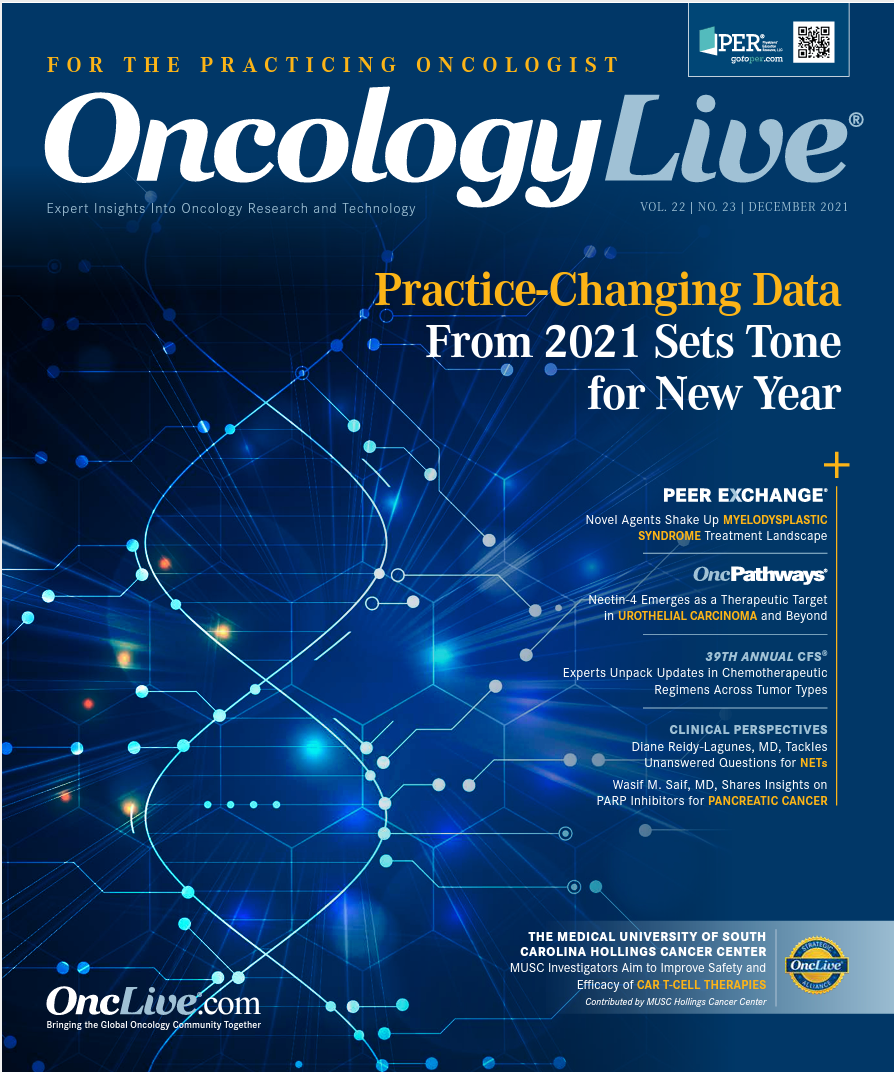Abemaciclib Becomes First Agent of its Kind Approved for Adjuvant Treatment of Early Breast Cancer
Stephen Johnston, MD, PhD, provides insight on the effect the approval of the CDK4/6 inhibitor abemaciclib has for patients with early breast cancer and how it will advance investigative efforts in this space.
Stephen Johnston, MD, PhD

Abemaciclib, a CDK4/6 inhibitor, has been approved in combination with tamoxifen or an aromatase inhibitor for the adjuvant treatment of adult patients with hormone receptor–positive, HER2-negative, node-positive early breast cancer at high risk of recurrence and a Ki-67 score of at least 20%, as determined by an FDA-approved test, based on data from the phase 3 MonarchE trial (NCT03155997).
The 36-month invasive disease-free survival rate among patients treated with abemaciclib plus tamoxifen or an aromatase inhibitor (n = 1017) was 86.1% (95% CI, 82.8%-88.8%) compared with 79% (95% CI, 75.3%-82.3%) in patients treated with tamoxifen or an aromatase inhibitor alone (n = 986). Approximately 16% of patients in the control group experienced an event vs 10.2% in the experimental arm (HR 0.0626; 95% CI, 0.488-0.803; P = .0042).
In an interview with OncLive®, Stephen Johnston, MD, PhD, head of Medical Oncology and head of the Breast Unit at The Royal Marsden NHS Foundation Trust and the Institute of Cancer Research in London, England, provided insight on the effect the approval of the CDK4/6 inhibitor has for patients with early breast cancer and how it will advance investigative efforts in this space.
What was the clinical rationale for studying this combination in this patient population?
In the MonarchE trial, we looked at patients who were deemed to be at high risk of recurrence following a diagnosis of [hormone receptor–] positive, HER2-negative early breast cancer. We were specifically selecting those who had lymph node–positive disease. We know they’re at higher risk. The layers of risk on top of that [baseline] were addressed as [either] 4 or more [positive] nodes, or if they had 1 to 3 [positive] lymph nodes. [Also,] patients had additional risks, such as a large tumor, high grade, or high proliferation. Despite the best standard of care, we estimated this population would, on average, [experience] relapse at a rate from 20% to 30% in the first 3 to 5 years, so there was room for improvement.
CDK inhibitors have already been shown to add [benefit] to endocrine therapy in advanced disease, as they overcome endocrine resistance and they control the cancer for longer. The question was: In early breast cancer, could we select an at-risk population and show that adding [a CDK inhibitor] for 2 years in addition to their endocrine therapy would [reduce the rate of] early recurrences in the f irst 2 to 3 years?
Please speak on how this approval will affect the treatment landscape for early breast cancer.
This is the first CDK4/6 inhibitor [approved] in early breast cancer, and that’s based on the level of efficacy seen in the MonarchE trial. The FDA label has specifically added the high–Ki-67 group, which was approximately 2500 patients in the trial, because they had an even greater risk of recurrence if they had an increased [number of positive] lymph nodes and other risk factors. That’s a group that derived a very significant gain in recurrent-free survival at the 3-year point.
This is a particularly high-risk group, where [the FDA] feels that the early recurrences in the first few years potentially could be prevented by the addition of the CDK inhibitor. [The approval] represents a very significant milestone in hormone positive–early breast cancer.
[With the approval,] we now have a new endocrine-based treatment, which we have not [seen an] approval for in nearly 20 years. It’s a paradigm shift because the last new treatment were the aromatase inhibitors in 2002. This represents our progress in understanding primary endocrine resistance, [identifying] patients who are destined to relapse despite the best therapies and developing interventions to stop those early recurrences.
This is a highly significant milestone for the small group of patients with highrisk disease, for whom endocrine therapy [alone] isn’t going to be the solution. We can make a significant difference for them. For many patients, endocrine therapy alone plus their current treatments can cure them. But, for around 15% of all patients with [hormone receptor–]positive breast cancer, they are destined to relapse relatively early despite endocrine treatment. For that group of patients, which we believe we can now identify, this makes for a big improvement in their outcome.
What does the future hold for abemaciclib in combination with endocrine therapy?
There are approximately 6 or 7 ongoing studies with CDK inhibitors in the early breast cancer setting, looking to see if we can further refine the group of patients who benefit. Trials in both a neoadjuvant and adjuvant setting are [evaluating CDK inhibitors] head-to-head against chemotherapy because chemotherapy is not always the answer for luminal hormone positivebreast cancer. That will be important because you could spare the toxicity of chemotherapy with this effective combination if it can be proven to be as effective or better.
Other studies are to refine the selection of endocrine-resistant disease. [Investigators are using a] technique of very short-term exposure to a hormone treatment in the 2 or 3 weeks before surgery and measuring Ki-67 [expression] to see whether hormone treatment switches that off. If it does, hormone treatment alone can be very good. However, hormone treatment will not switch off cell proliferation in approximately 20% of patients. [To overcome this,] investigators of the POETIC-A study [NCT04584853] will identify those where the proliferation is not being switched off and randomize them to abemaciclib [or endocrine therapy] after [surgery].
The label [indicates abemaciclib] for large, node-positive tumors. The [patients in POETIC-A] may have smaller tumors or node-negative disease, [representative of] a group of patients with biologically resistant tumors to endocrine therapy, who may not have high clinical pathological risk factors. That may be the next setting where this drug could be refined to have a niche role.
Reference
- Verzenio. Prescribing information. Eli Lilly and Company; 2021. Accessed November 5, 2021. bit.ly/3BUraOU




